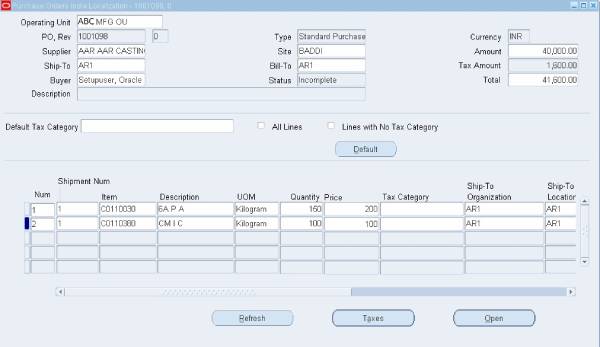REQUEST FOR QUOTATION(RFQ)
A request for quotation (RFQ) is a document that is submitted to a supplier to request pricing and other information for a specific item or items.Creating an RFQ in the RFQs window and delivering it through fax or telephone call are two examples of how you can send an RFQ to a supplier.
There are three sorts of RFQs.
1. Standard RFQ: For products you’ll only need once or rarely, but not necessarily for a precise, defined quantity, place or date.
For instance, you may utilise a Catalog quotation or RFQ for office supplies but a Standard quotation or RFQ for a rare sort of pen.
Price breaks at different quantity levels are also included in a standard quotation or RFQ.
If you wish to form a Blanket Purchase Agreement, use Standard RFQ.
2. Bid RFQ: For a precise quantity, location, and date, use a bid RFQ.
A Bid, for example, would be utilized for a huge or expensive piece of equipment that you’ve never ordered before.
3. Catalog RFQ: For high-volume commodities or items for which your supplier sends you information on a regular basis, use this method.
Price breaks at different quantity levels are also included in a Catalog quotation or RFQ.
HOW TO CREATE RFQ DIRECTLY?
Navigation
India Local Purchasing → RFQ’s and Quotations → RFQ’s
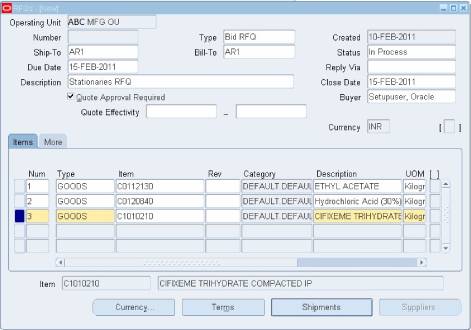
1. Choose Bid RFQ as the type.
2. Fill in the Ship To and Bill To addresses.
3. Fill in the RFQ’s Due Date and Closing Date.
4. ‘In process’ will be the status.
5. The Buyer’s name is automatically filled in.
The following are the definitions for each of the fields:-
Status: The Status field can be used to regulate the RFQ’s status.
• In Process – This is the status when the RFQ is first created.
• Active – Select this option when the RFQ is finished and you’re ready to submit it to your vendors.
The only RFQs that are currently active are printed.
• Printed – The status given to the RFQ once at least one copy has been printed.
If you want to reprint the RFQ, you must update the status to Active.
• Closed – Select this state to end the RFQ once all suppliers have answered or if you no longer require responses. When you close an RFQ, Purchasing deletes any associated follow-up notifications.
Due Date: Indicate when you want your suppliers to respond.The response due date is printed on the RFQ by purchasing.If the current date is between the RFQ reply due date and the close date, and the RFQ is active, Purchasing will notify you.
Reply Via: Enter the Reply/Receive Via code for the method you want the supplier to use to send the quotation. For example, by mail, telephone, or FAX.
Close Date: Enter the Close Date for the RFQ. Purchasing prints the close date on the RFQ. Purchasing notifies you if the current date is between the RFQ reply due date and the close date and if the RFQ is Active. Purchasing warns you when you enter a quotation against this RFQ after the close date.
Require Quote Approval: Select Require Quote Approval to enforce approval of any quotation referencing this RFQ before the quotation can be used for a purchase order.
Buyer: Purchasing displays your name as the Buyer. You can forward the RFQ to another buyer by choosing the name of this buyer from the list of values. The buyer you enter receives all notifications regarding this RFQ.
Dates: Enter the beginning and ending Effectively Dates for the supplier quotation
6. Enter the Quantity for each line which you intend to Purchase from the Supplier in the Shipments window.
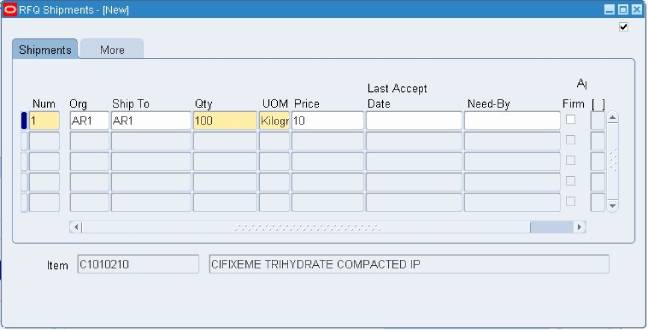
7. Save the RFQ. RFQ number will be auto generated.

8. Choose the Suppliers to whom you’d like to send this RFQ from the list.
Click the “Supplier” button in the RFQ box. The next window appears.
9. To save time, you may either choose the Suppliers one by one or use a preset List from the ADD From List Tab.
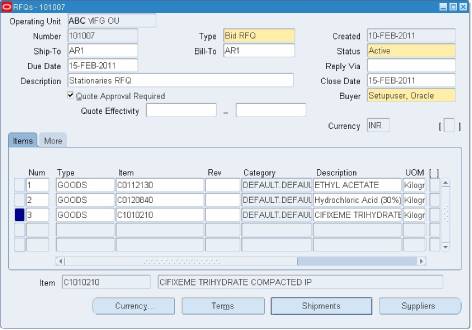
QUOTATIONS
A quotation is a supplier’s answer to a request for quotation. After you’ve gotten responses from the Supplier in response to the RFQ, you’ll need to create a Quotation.
You can do this either by copying the RFQ into a Quotation or by preparing a Quotation independently to save time.
Navigation
India Local Purchasing → RFQ’s and Quotations → Quotations (Localized)
1. Select the Type for the Quotation. In this case ‘Type’ will be Bid Quotation only.
2. Select the Supplier and its Site address against whom you want to enter the quotation.

3. Now query for the RFQ number against which you want to enter the Quotation. The RFQ field becomes enter-able only when the Supplier’s name is entered in the quotation form.

4. Based on the RFQ given to the Supplier, input all line detail information. Input the price for the RFQ based on the quote obtained from the Supplier.
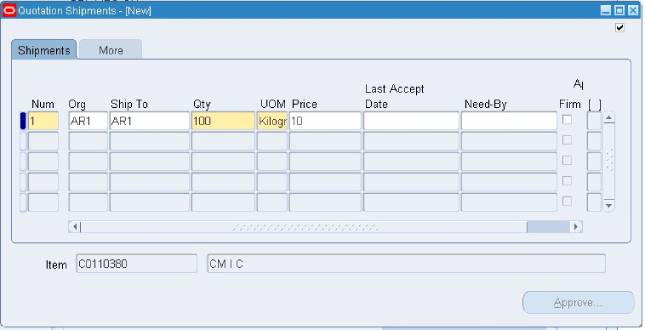
5. We must enter the taxes after we have completed the price and all other details as shown in the screen shot.

6. Input taxes are applied to each line item as specified in the Supplier Quotation.
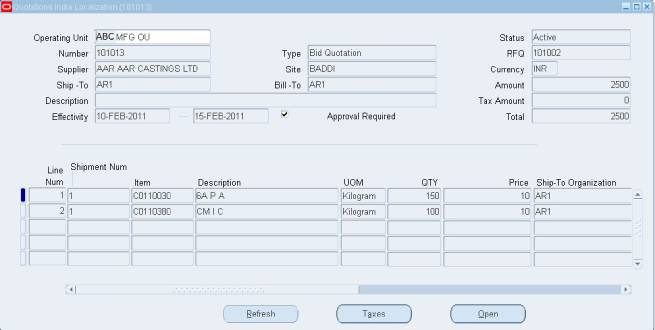
7. To enter the taxes, go to the taxes tab. Select the applicable tax from the Tax Name LOV drop-down menu. Put the appropriate value in the Precedence field and click Apply.
8. Fill in the taxes for all of the lines in the quotation as needed.
9. Save it and make sure the Quotation Status is set to Active
QUOTE ANALYSIS
Once all of the Quotations for a specific RFQ have been received from all of the Suppliers, Quote Analysis can be used to determine the best Supplier to whom the order should be placed. Quote Analysis is a workbench that shows all of the quotes for an item, supplier, RFQ, or quotation.
- Enter the RFQ number for which you’ve received quotations.
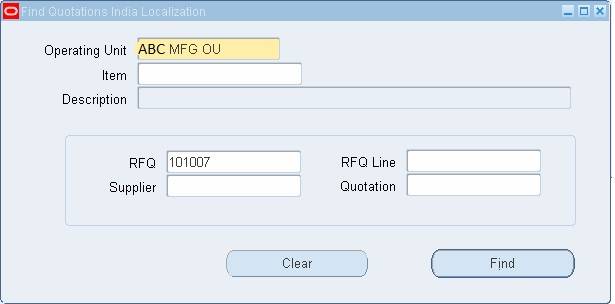
2. Select the Find tab. The appropriate taxes against each line for a particular quotation can be inspected by clicking on the Taxes field.

3. Approve a quotation for creating a Purchase Order based on the quote analysis.
To approve a quotation, proceed to the menu navigation listed below.
Navigation : India Local Purchasing –> RFQ’s and Quotations –> Quote Analysis
The procedure for querying quotations against a specific RFQ is the same as previously described. When you run a query, the screen shot below shows.


4. Approve the quotation based on the quotation analysis. Click OK after clicking Approve the whole Quotation. This will give your approval to all of the quotation lines.
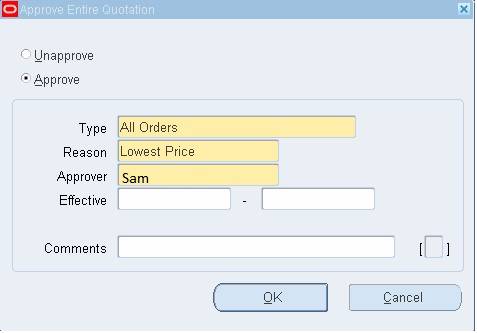
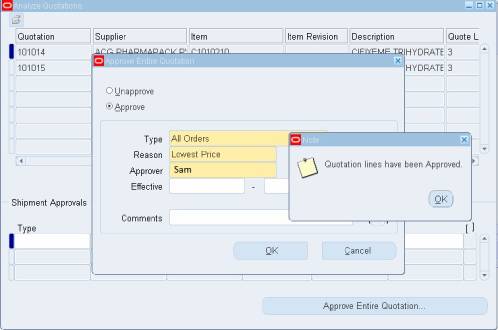
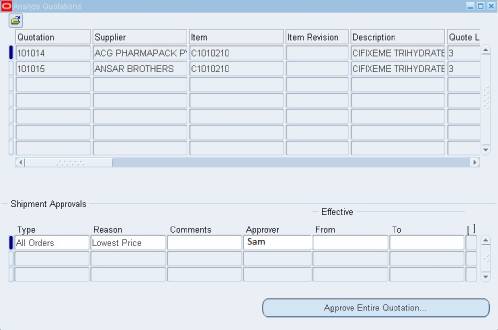
AUTOCREATE – REQUISITION TO RFQ
This allows RFQs to be generated straight from requisitions. As a result, data entering time is reduced.
Navigation
India Local Purchasing → Auto Create
1. Open the Autocreate form. Clear the records by clicking onto ‘Clear’ tab.
2. Enter the requisition number that needs to be auto created to Request For Quotation(RFQ). Click onto the Find Tab.
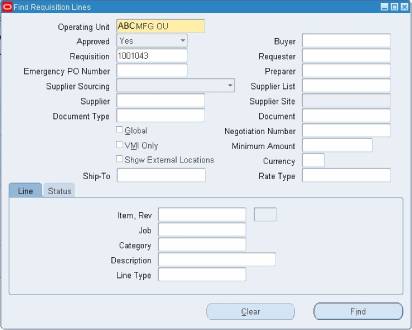
3. Select the requisition lines that need to enter onto the RFQ. You can select the whole requisition or few lines pertaining to that requisition
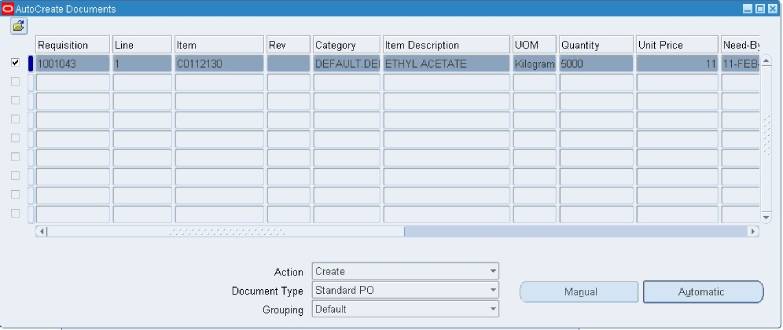
4. From the Action LOV select Create to create new RFQ’s.
5. From the Document Type LOV select RFQ.
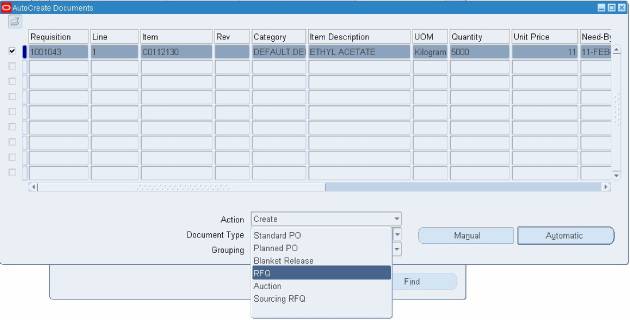
6. Now click onto Automatic tab to create RFQ from requisition.

7. You’ll see the screen below. Select Bid RFQ as the RFQ Type. To make an RFQ, go to the ‘Create’ tab.

8. RFQ will be auto-created.
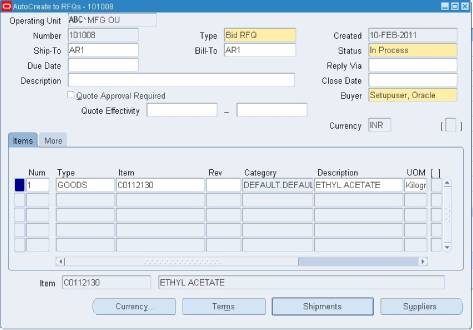
9. All other steps are same as discussed under Request for Quotations (RFQ).
AUTOCREATE – RFQ TO QUOTATION
Quotations can be generated immediately from RFQs. As a result, data entry will take less time. Using Autocreate, create quotes from RFQs.
Navigatzion
India Local Purchasing → RFQ’s and Quotations → RFQ’s (Localized)
- In the RFQ (Localized) form, look for the RFQ number. Set the status to “Active.”
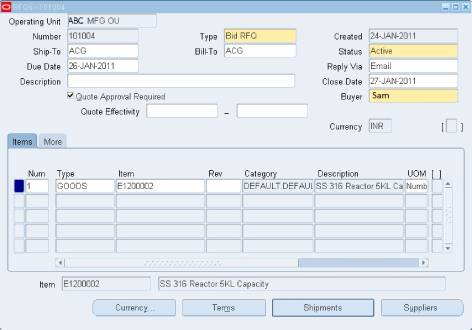
2. Go to the Suppliers tab and search for the Suppliers to whom the RFQ was sent.
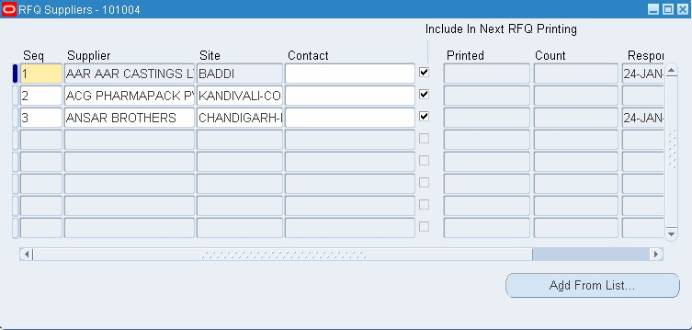
3. Click onto the Tools → Copy Document option.
4. You’ll see the screen below.
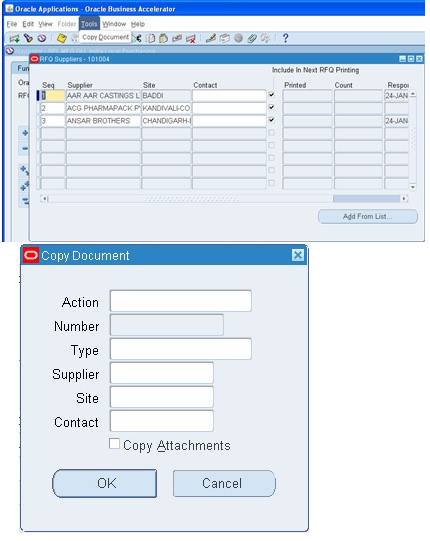
5. Fill in the blanks with the information below. Choose one of the three alternatives. The first choice, ‘Entire RFQ,’ is selected in this scenario, implying that a quotation is generated from the RFQ header, lines, and shipments.

6. Select Bid Quotation as the quotation type. The suppliers to whom the RFQ was sent will appear against the Supplier LOV. To enter the quotation details, select each supplier one by one.
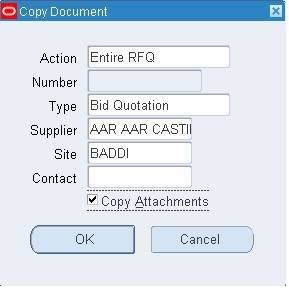
7. Click OK to finish. The Quotation number is mentioned on a screen.
8. Finally, press the OK key. The screen that comes next appears.
9. Change the Status to “Active” in the Quotation Header, and then enter the prices in the Quotation by selecting Shipments tab against each of the Line items. Approval can only be requested for Quotations that are “Active.”
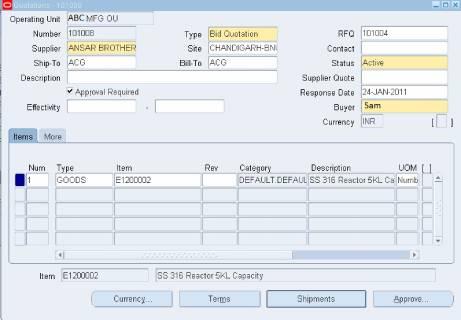
10. On the Quotation (Localized) form, click the Taxes tab to enter the necessary taxes.
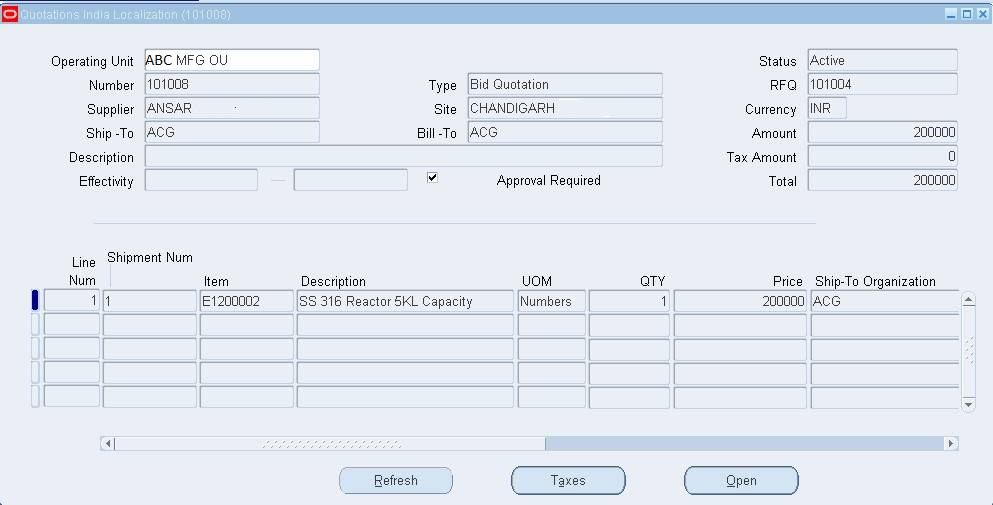
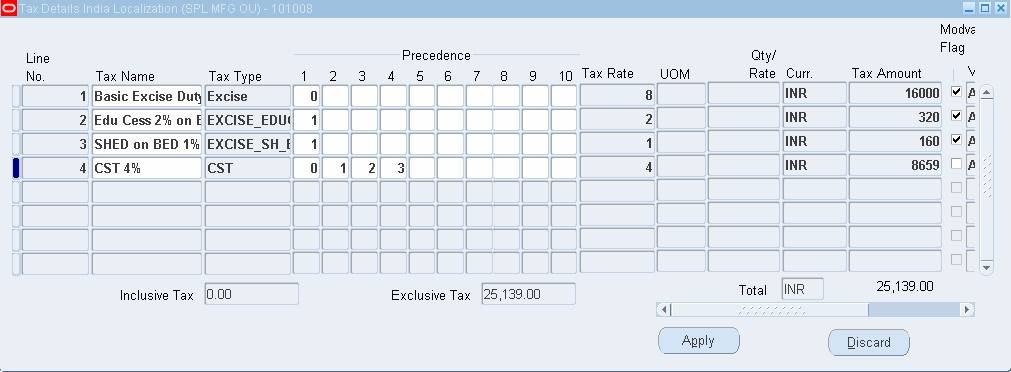
Fill in the tax amounts for each line of the quotation. Save it by clicking Apply.
11. Once all of the taxes have been entered for a quotation, the total tax value will be displayed in the header of the Quotation (Localized) form.
12. You have the Option to approve either a Quotation Line , or the Entire Quotation.
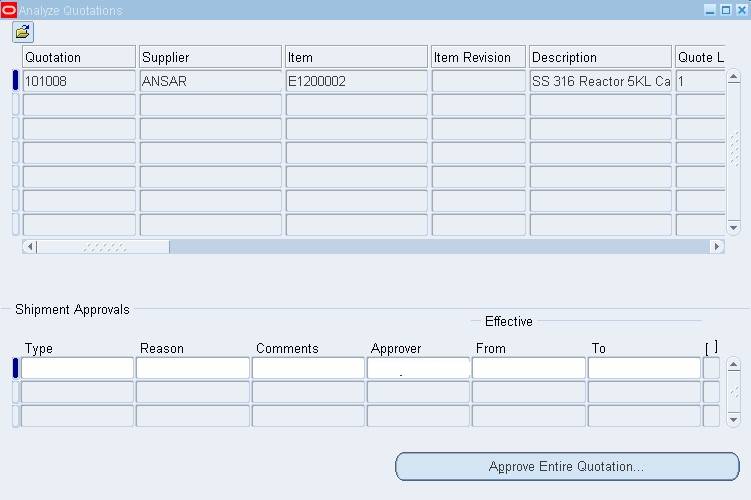
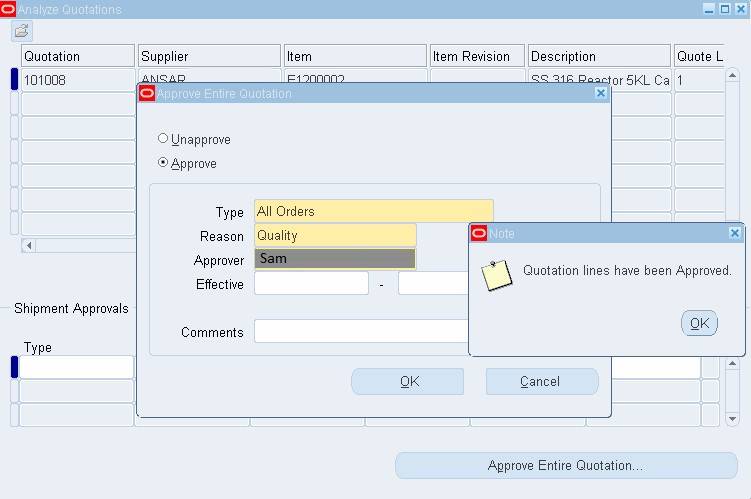
13. Press OK to approve the quotation. Enter the Approval Type: Approval types determine the types of documents on which you can use the quotation. The available types are: All Orders (all types of purchase orders and requisitions), Purchase Agreements, Requisitions, and Standard Purchase Orders.
Enter the approval’s name here. When you make a purchase, your name is automatically entered in this form. This field is only available if Approve is selected as the action.
Unlike Purchase Orders, Quotation does not follow the Approval Position Hierarchy.Click OK after filling out the Approver name.
AUTOCREATE – PO FROM QUOTATIONS
You can create a purchase order directly from a quotation. This will reduce data entry time, and any taxes entered in the supplier’s quotation will be defaulted in the PO created as a result.
Navigation
India Local Purchasing → RFQ’s and Quotations → Quotations → RFQ’s Query the Quotation (Press F1, Ctrl+F11)
1. Create a Standard Purchase Order from the approved Bid Quotation.
2. In the Quotation window, query the quotation. Click on Tools and Copy Document. Select Document Type as ‘Standard Purchase Order’. Click on OK .
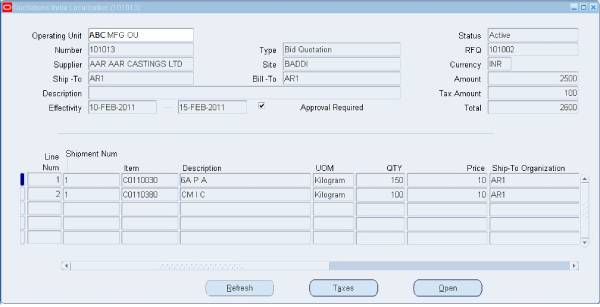

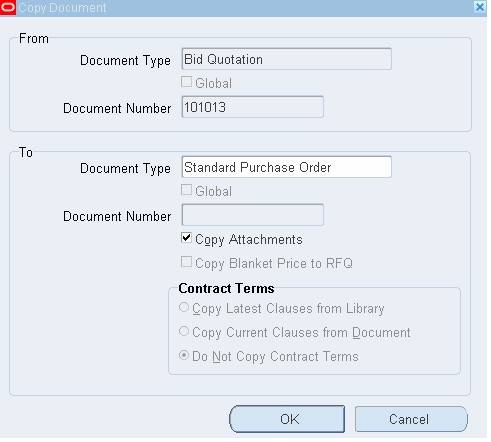
3. The following screen will appears.

4. Click OK. The Purchase Order will be created automatically.
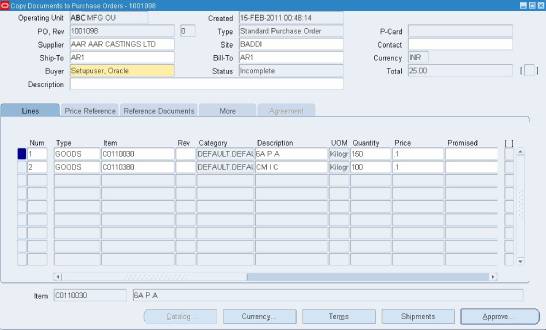
All lines established on the Purchase Order, including Bill To and Ship To, as well as Prices, are defaulted from the quotation line. The tax portion of the quotation is also copied.To see the same, go to the navigation shown below.
Navigation
India Local Purchasing → India Localization → Purchase Orders → Purchase Orders(Localized)
